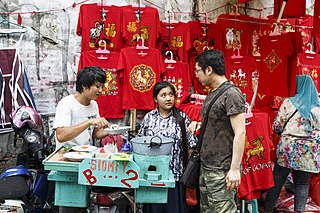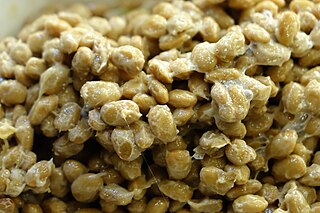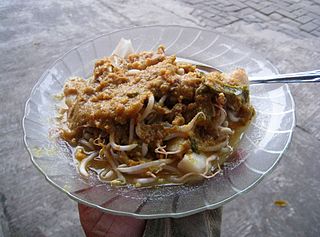
This is a list of tofu dishes. Tofu, also called bean curd, is a food made by coagulating soy milk and then pressing the resulting curds into soft white blocks. It is a component in many East Asian and Southeast Asian cuisines. [1] [2]

This is a list of tofu dishes. Tofu, also called bean curd, is a food made by coagulating soy milk and then pressing the resulting curds into soft white blocks. It is a component in many East Asian and Southeast Asian cuisines. [1] [2]




Douhua is a Chinese sweet or savoury snack made with very tender tofu. It is also referred to as doufuhua, tofu pudding, soybean pudding or, particularly in northern China, tofu brains.

Douchi or tochi is a type of fermented and salted black soybean. In English, it is known as fermented black soybeans, Chinese fermented black beans, salted black beans, salty black beans, or just black beans. They are a flavoring most popular in the cuisine of China, where they are most widely used for making black bean sauce dishes.

Tofu skin, beancurd skin, beancurd sheet, or beancurd robes is a food product made from soybeans. During the boiling of soy milk, in an open shallow pan, a film or skin composed primarily of a soy protein-lipid complex forms on the liquid surface. The films are collected and dried into yellowish sheets known as tofu skin. Since tofu skin is not produced using a coagulant, it is not technically a proper tofu; however, it does have similar texture and flavor to some tofu products.

Fermented tofu is a Chinese condiment consisting of a form of processed, preserved tofu used in East Asian cuisine. The ingredients typically are soybeans, salt, rice wine and sesame oil or vinegar. In mainland China the product is often freshly distributed. In overseas Chinese communities living in Southeast Asia, commercially packaged versions are often sold in jars containing blocks 2- to 4-cm square by 1 to 2 cm thick soaked in brine with select flavorings.

Chinese Indonesian cuisine is characterized by the mixture of Chinese with local Indonesian style. Chinese Indonesians, mostly descendant of Han ethnic Hokkien speakers, brought their legacy of Chinese cuisine, and modified some of the dishes with the addition of Indonesian ingredients, such as kecap manis, palm sugar, peanut sauce, chili, santan and local spices to form a hybrid Chinese-Indonesian cuisine. Some of the dishes and cakes share the same style as in Malaysia and Singapore which are known as the Nonya cuisine by the Peranakan.

Okara, soy pulp, or tofu dregs is a pulp consisting of insoluble parts of the soybean that remain after pureed soybeans are filtered in the production of soy milk and tofu. It is generally white or yellowish in color. It is part of the traditional cuisines of Japan, Korea, and China. Since the 20th century, it has been used in the vegetarian cuisines of Western nations.

Jjigae is a Korean stew. There are many varieties; it is typically made with meat, seafood or vegetables in a broth seasoned with gochujang, doenjang, ganjang or saeujeot. Jjigae is usually served in a communal dish, boiling hot.

Cheonggukjang is a traditional Korean food made by fermenting soybeans. It contains whole, as well as ground soybeans.

Tokwa't baboy is a typical Philippine appetizer. It consists of pork ears, pork belly and deep-fried tofu, and is served in a mixture of soy sauce, pork broth, vinegar, chopped white onions, scallions and red chili peppers. It is usually served as pulutan, as a meal served with rice or as a side dish to rice porridge. Tokwa is the Lan-nang word for firm beancurd, while baboy is the Tagalog word for pork; 't is the contracted form of at, which means "and".

Sundubu-jjigae or soft tofu stew is a jjigae in Korean cuisine. The dish is made with freshly curdled soft tofu, vegetables, sometimes mushrooms, onion, optional seafood, optional meat, and gochujang or gochu garu. The dish is assembled and cooked directly in the serving vessel, which is traditionally made of thick, robust porcelain, but can also be ground out of solid stone. A raw egg can be put in the jjigae just before serving, and the dish is delivered while bubbling vigorously. It is typically eaten with a bowl of cooked white rice and several banchan.

Doenjang-jjigae, referred to in English as soybean paste stew, is a Korean traditional jjigae, made from the primary ingredient of doenjang, and additional optional ingredients vegetables, seafood, and meat. It is one of the most iconic and popular traditional dishes in Korean cuisine, and is often eaten regularly regardless of occasion or time of day. Doenjang-jjigae was initially made with home-made doenjang; however, due to extensive industrialisation of soybean paste, households and restaurants nowadays use factory-made doenjang instead as their ingredient. From traditional to modern Korean cuisine, doenjang has become one of the most frequently used jang (sauce/paste). It is claimed as a national dish.

Tofu, also known as bean curd, is a food prepared by coagulating soy milk and then pressing the resulting curds into solid white blocks of varying softness; it can be silken, soft, firm, extra firm or super firm. Beyond these broad textural categories, there are many varieties of tofu. It has a subtle flavor, so it can be used in savory and sweet dishes. It is often seasoned or marinated to suit the dish and its flavors, and due to its spongy texture it absorbs flavors well.

Sundanese cuisine is the cuisine of the Sundanese people of Western Java, and Banten, Indonesia. It is one of the most popular foods in Indonesia. Sundanese food is characterised by its freshness; the famous lalab eaten with sambal and also karedok demonstrate the Sundanese fondness for fresh raw vegetables. Unlike the rich and spicy taste, infused with coconut milk and curry of Minangkabau cuisine, the Sundanese cuisine displays the simple and clear taste; ranged from savoury salty, fresh sourness, mild sweetness, to hot and spicy.

Tauco, Taucu, Taotjo or Tauchu is a paste made from preserved fermented yellow soybeans in Chinese Indonesian and Malaysian cuisines. Tauco is made by boiling yellow soybeans, grinding them, mixing them with flour and fermenting them in order to make a soy paste. The soy paste is soaked in salt water and sun-dried for several weeks, furthering the fermentation process, until the color of the paste has turned yellow-reddish. Good tauco has a distinct aroma. The sauce is also commonly used in other Indonesian cuisines traditions, such as Sundanese cuisine and Javanese cuisine. Taucu is generally used in cooking by Chinese Malaysian, Singaporean and Bruneian.

Mapo tofu is a popular Chinese dish from Sichuan province. It consists of tofu set in a spicy sauce, typically a thin, oily, and bright red suspension, based on douban, and douchi, along with minced meat, traditionally beef. Variations exist with other ingredients such as water chestnuts, onions, other vegetables, or wood ear fungus. One account indicates that the dish existed as early as 1254, in a suburb of Chengdu, the capital city of Sichuan province.

Tauge goreng is an Indonesian savoury vegetarian dish made of stir-fried tauge with slices of tofu, ketupat or lontong rice cake and yellow noodles, served in a spicy oncom-based sauce. Tauge goreng is a specialty of Jakarta and Bogor city, West Java, Indonesia. It is usually sold as street food using pikulan or gerobak (cart) by street vendors. It is a popular street food in Indonesia, especially in Jakarta, and Greater Jakarta areas, including Bogor, Depok, Tangerang and Bekasi.

Sapo tahu is a Chinese Indonesian tofu dish traditionally cooked and served in claypot. Sapo tahu may be served as a vegetarian dish, or with chicken, seafood, minced beef or pork. It is a popular tofu dish in Indonesia, with several Chinese restaurants competing to serve the best-tasting sapo tahu in Jakarta.